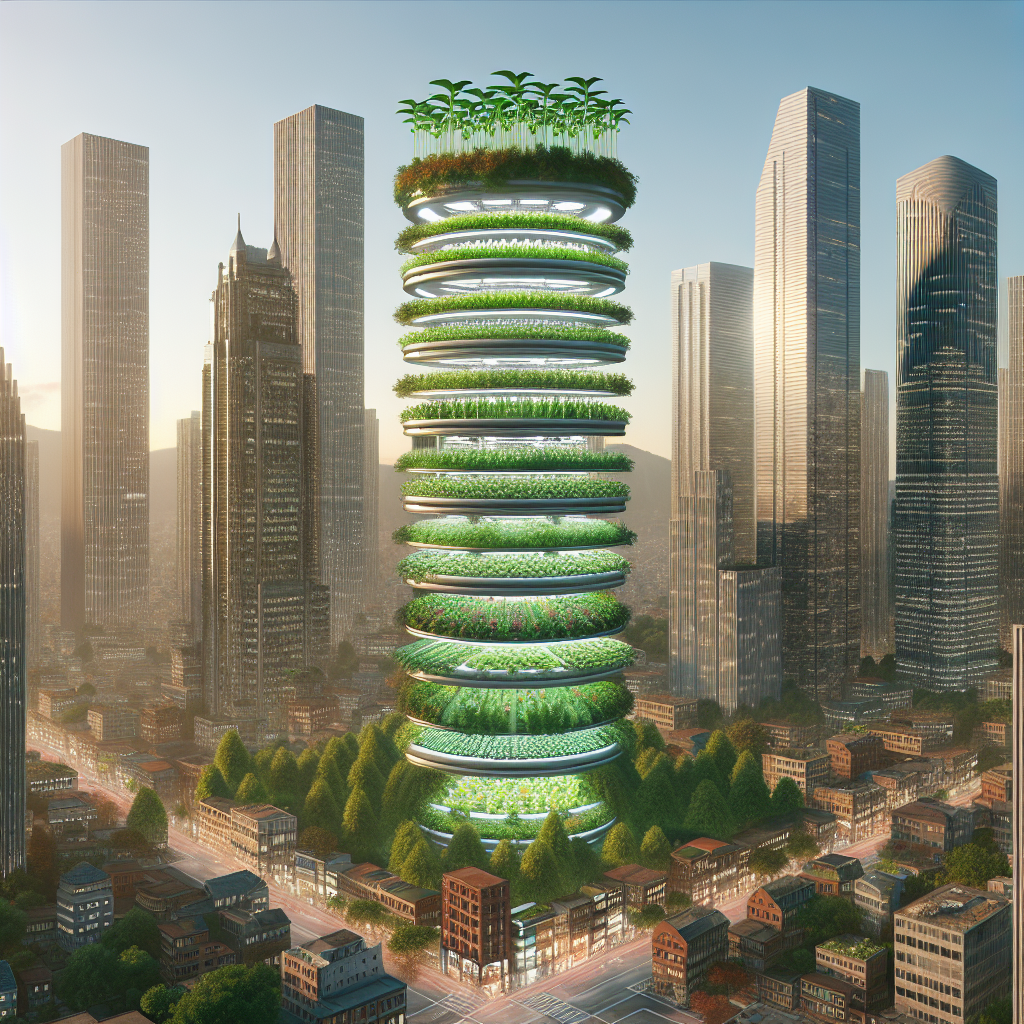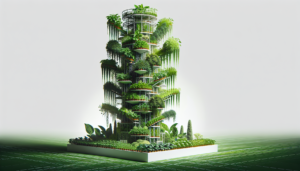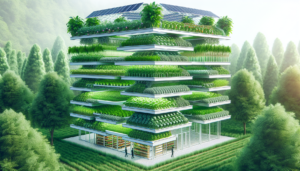
Imagine a future where fresh and nutritious produce is grown right in the heart of our cities, eliminating the need for long-distance transportation and reducing the carbon footprint. Welcome to the world of vertical farming, a revolutionary concept that is reshaping the way we think about agriculture. In this captivating journal, we will delve into the fascinating world of vertical farming, exploring its potential to provide sustainable and locally-grown food for our growing urban populations. Get ready to be amazed by the possibilities that vertical farming holds for the future.
Introduction to Vertical Farming Revolution
What is Vertical Farming?
Vertical farming is an innovative agricultural practice that involves growing crops vertically, in stacked layers or vertical towers, instead of the traditional method of horizontal farming. This approach maximizes the use of space, allowing for more crops to be grown in a smaller footprint.
The Need for Vertical Farming
With the world’s population projected to reach over 9 billion by 2050, the demand for food will continue to rise. However, traditional agriculture practices have limitations in meeting this growing demand. Vertical farming presents a sustainable solution to this challenge by optimizing land use, increasing food production, and enhancing food security.
Advantages of Vertical Farming
Vertical farming offers several advantages over traditional farming methods. Firstly, it allows for year-round crop production, eliminating the dependence on seasonal conditions. Secondly, it optimizes water usage, conserving this precious resource. Additionally, vertical farming minimizes the use of pesticides, leading to healthier and more nutritious crops. Lastly, vertical farming can be established in urban areas, reducing the need for long-distance transportation and ensuring fresh produce for city dwellers.
The Technology Behind Vertical Farming
Vertical Farming Systems
Vertical farming utilizes various systems, including hydroponics and aeroponics. Hydroponics involves growing plants in nutrient-rich water without soil, while aeroponics suspends the plant roots in air and mists them with nutrient solutions. These systems enable efficient resource utilization and maximize crop yields.
Smart Lighting
In vertical farming, artificial lighting plays a crucial role in providing plants with the necessary light spectrum for photosynthesis. Smart lighting systems use LED technology to tailor the light spectrum, intensity, and duration to suit the specific plant’s growth stage. This precise control promotes faster growth and higher quality crops.
Hydroponics and Aeroponics
Hydroponics and aeroponics are alternative cultivation methods used in vertical farming. These soil-less techniques provide plants with the necessary nutrients and water directly to their roots, resulting in faster growth and increased yields. By eliminating the need for soil, vertical farms can be set up in urban areas with limited space.
Automation and Robotics
To optimize operations and reduce labor costs, vertical farms often rely on automation and robotics. Automated systems control temperature, humidity, and nutrient levels, ensuring optimal growing conditions. Robots assist in planting, harvesting, and maintaining crops, enhancing efficiency and productivity.
Environmental Benefits of Vertical Farming
Conservation of Water Resources
Vertical farming utilizes efficient irrigation systems, such as drip irrigation or nutrient film technique, which significantly reduce water consumption compared to traditional farming. Additionally, the closed-loop system employed in vertical farms allows for water recycling, minimizing wastage and promoting water conservation.
Reduced Land Usage
By growing crops vertically, vertical farming reduces the amount of land needed for agriculture. This is particularly beneficial in urban areas with limited space. Vertical farms can be established in vacant buildings or repurposed structures, ensuring that valuable land is preserved for other purposes.
Decreased Environmental Impact
Vertical farming has a lower environmental impact compared to traditional agriculture. By minimizing the use of pesticides and herbicides, it reduces chemical contamination in soil and water. Additionally, vertical farms often incorporate sustainable practices such as using renewable energy sources, further reducing carbon emissions.
Increased Food Production
Year-Round Crop Production
Vertical farming allows for year-round crop production, independent of seasonal variations. With controlled environments and artificial lighting, crops can be grown continuously, ensuring a consistent food supply and reducing reliance on external sources during off-seasons.
Eliminating Seasonal Constraints
In traditional farming, seasonal limitations affect crop yields. Adverse weather conditions, temperature fluctuations, and pests can severely impact harvests. Vertical farming mitigates these constraints by providing optimal growing conditions throughout the year, resulting in higher and more reliable crop yields.
Production in Urban Areas
The ability of vertical farming to be established in urban areas is a significant advantage. By bringing food production closer to consumers, vertical farms reduce the need for long-distance transportation, thereby decreasing carbon emissions. This localized production also ensures that urban populations have access to fresh, nutritious produce.
Economic Implications
Job Creation
The rise of vertical farming creates new job opportunities in a range of fields. These include positions in technical support, maintenance, research and development, and marketing. Additionally, as vertical farming expands globally, it stimulates job growth in related sectors such as manufacturing of specialized equipment and infrastructure development.
Economic Viability
Vertical farming has the potential to be economically viable in the long run. While initial investments may be high, the technology and efficiency improvements over time can lead to decreased operational costs. As the demand for locally grown, fresh produce increases, vertical farms can capitalize on this market opportunity, making it a financially sustainable venture.
Cost-Effectiveness for Consumers
Vertical farming has the potential to offer cost-effective solutions for consumers. As vertical farms are established closer to urban areas, transportation costs are reduced, resulting in lower prices for fresh produce. Additionally, the ability to grow crops year-round reduces price fluctuations caused by seasonal constraints, ensuring a stable and affordable food supply.
Enhancing Food Security
Combating Food Shortages
Vertical farming plays a vital role in combating food shortages, especially in areas with limited arable land or prone to natural disasters. By utilizing vertical space more efficiently, vertical farms can produce higher crop yields compared to traditional agriculture. This increased productivity contributes to a more secure and sustainable food supply.
Reducing Reliance on Imports
Many countries heavily rely on imports to meet their food demands. Vertical farming offers the opportunity to produce a significant portion of the required crops locally, reducing dependence on external sources. This reduces the vulnerability to supply chain disruptions and promotes self-sufficiency in food production.
Improving Nutritional Value
Optimization of Nutrient Content
Vertical farming enables precise control over nutrient delivery to plants, allowing for optimization of their nutrient content. By tailoring the nutrient composition, crops can be grown to be more nutritious, providing a wide range of vitamins, minerals, and phytochemicals. This enhanced nutritional value contributes to better overall health and well-being.
Reduced Need for Pesticides
One of the main advantages of vertical farming is the reduced need for pesticides. By utilizing controlled environments and advanced monitoring systems, vertical farms can greatly minimize the occurrence of pests and diseases. Consequently, crops grown in vertical farms have lower pesticide residues, providing consumers with safer and healthier food options.
Challenges and Limitations
High Initial Investment
Establishing a vertical farm requires significant upfront investment in infrastructure, technology, and specialized equipment. While the costs associated with vertical farming have been decreasing, it still remains a barrier for many potential investors. However, as the technology advances and economies of scale come into play, the initial investment is becoming more accessible.
Energy Consumption
Vertical farming relies heavily on artificial lighting, which can contribute to increased energy consumption. While advancements in LED technology have made lighting more energy-efficient, reducing energy consumption further remains a challenge. Integrating renewable energy sources into vertical farming systems can help mitigate the environmental impact associated with energy consumption.
Technological Limitations
Although vertical farming has made significant strides in recent years, there are still technological limitations that need to be addressed. Fine-tuning the control systems, optimizing crop growth algorithms, and developing more efficient cultivation techniques are areas that require further research and development. Overcoming these limitations will lead to even greater productivity and efficiency in vertical farming.
Examples of Successful Vertical Farms
AeroFarms in New Jersey, USA
AeroFarms is a leading vertical farming company located in Newark, New Jersey. They have transformed a former steel mill into a state-of-the-art vertical farm. AeroFarms utilizes aeroponic technology and LED lighting to grow a variety of leafy greens in a highly efficient and sustainable manner. Their innovative approach has been recognized globally as a successful model for vertical farming.
Sky Greens in Singapore
Sky Greens is a vertical farm in Singapore that has gained recognition for its innovative and sustainable practices. They utilize a rotating vertical farming system, allowing for efficient use of space and natural sunlight. Sky Greens produces a range of vegetables that are supplied locally, reducing the city-state’s dependence on imports and promoting food security.
Mirai in Japan
Mirai is a vertical farm located in Miyagi Prefecture, Japan. They specialize in the cultivation of lettuce and herbs using hydroponic technology. Mirai’s vertical farm is fully automated and runs on renewable energy, making it a sustainable and environmentally friendly operation. With their focus on quality and freshness, Mirai has become a leading producer of high-quality produce in Japan.
Future Prospects and Conclusion
Advancements in Vertical Farming Technology
The future of vertical farming holds great promise. Continued advancements in technology, such as improvements in LED lighting efficiency, automation, and artificial intelligence, will drive further growth in the industry. These advancements will lead to increased productivity, reduced costs, and the ability to grow a wider variety of crops in vertical farms.
Integration with Smart Cities
Vertical farming has the potential to integrate with smart city initiatives, promoting sustainability and resilience. By utilizing vertical space within urban areas, vertical farms can contribute to a more localized and efficient food production system. Coupled with renewable energy sources and advanced waste management systems, vertical farming can play a significant role in building smart and sustainable cities.
Conclusion
Vertical farming revolutionizes agriculture by bringing food production closer to urban areas, maximizing resources, and increasing food security. This innovative approach offers a range of environmental, economic, and nutritional benefits. While challenges exist, ongoing advancements in technology and increased adoption of vertical farming globally position it as a vital solution to meet the growing demands of a rapidly increasing global population. As vertical farming continues to evolve, society can look forward to a future where sustainable food production becomes the norm.







